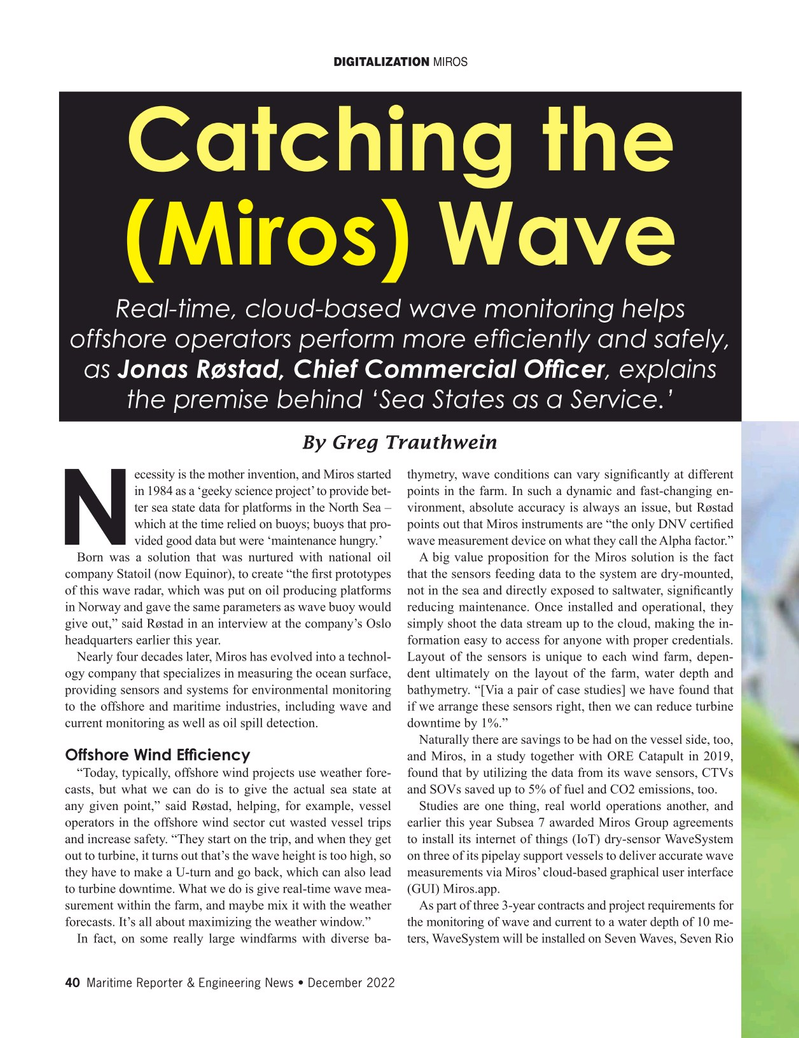
Page 40: of Maritime Reporter Magazine (December 2022)
Great Ships of 2022
Read this page in Pdf, Flash or Html5 edition of December 2022 Maritime Reporter Magazine
DIGITALIZATION MIROS
Catching the (Miros) Wave
Real-time, cloud-based wave monitoring helps offshore operators perform more ef? ciently and safely, as Jonas Røstad, Chief Commercial Of? cer, explains the premise behind ‘Sea States as a Service.’
By Greg Trauthwein ecessity is the mother invention, and Miros started thymetry, wave conditions can vary signi? cantly at different in 1984 as a ‘geeky science project’ to provide bet- points in the farm. In such a dynamic and fast-changing en- ter sea state data for platforms in the North Sea – vironment, absolute accuracy is always an issue, but Røstad which at the time relied on buoys; buoys that pro- points out that Miros instruments are “the only DNV certi? ed
Nvided good data but were ‘maintenance hungry.’ wave measurement device on what they call the Alpha factor.”
Born was a solution that was nurtured with national oil A big value proposition for the Miros solution is the fact company Statoil (now Equinor), to create “the ? rst prototypes that the sensors feeding data to the system are dry-mounted, of this wave radar, which was put on oil producing platforms not in the sea and directly exposed to saltwater, signi? cantly in Norway and gave the same parameters as wave buoy would reducing maintenance. Once installed and operational, they give out,” said Røstad in an interview at the company’s Oslo simply shoot the data stream up to the cloud, making the in- headquarters earlier this year. formation easy to access for anyone with proper credentials.
Nearly four decades later, Miros has evolved into a technol- Layout of the sensors is unique to each wind farm, depen- ogy company that specializes in measuring the ocean surface, dent ultimately on the layout of the farm, water depth and providing sensors and systems for environmental monitoring bathymetry. “[Via a pair of case studies] we have found that to the offshore and maritime industries, including wave and if we arrange these sensors right, then we can reduce turbine current monitoring as well as oil spill detection. downtime by 1%.” Naturally there are savings to be had on the vessel side, too,
Offshore Wind Ef? ciency and Miros, in a study together with ORE Catapult in 2019, “Today, typically, offshore wind projects use weather fore- found that by utilizing the data from its wave sensors, CTVs casts, but what we can do is to give the actual sea state at and SOVs saved up to 5% of fuel and CO2 emissions, too.
any given point,” said Røstad, helping, for example, vessel Studies are one thing, real world operations another, and operators in the offshore wind sector cut wasted vessel trips earlier this year Subsea 7 awarded Miros Group agreements and increase safety. “They start on the trip, and when they get to install its internet of things (IoT) dry-sensor WaveSystem out to turbine, it turns out that’s the wave height is too high, so on three of its pipelay support vessels to deliver accurate wave they have to make a U-turn and go back, which can also lead measurements via Miros’ cloud-based graphical user interface to turbine downtime. What we do is give real-time wave mea- (GUI) Miros.app.
surement within the farm, and maybe mix it with the weather As part of three 3-year contracts and project requirements for forecasts. It’s all about maximizing the weather window.” the monitoring of wave and current to a water depth of 10 me-
In fact, on some really large windfarms with diverse ba- ters, WaveSystem will be installed on Seven Waves, Seven Rio 40 Maritime Reporter & Engineering News • December 2022
MR #12 (34-43).indd 40 12/6/2022 1:45:44 PM

 39
39

 41
41
